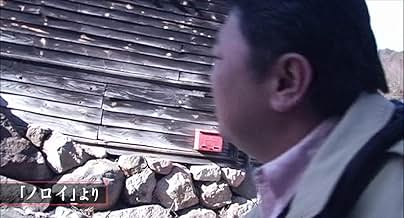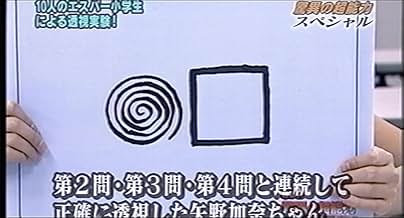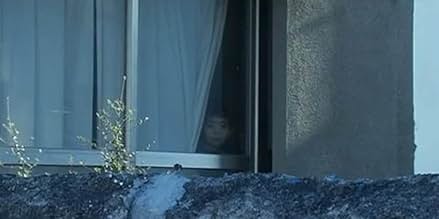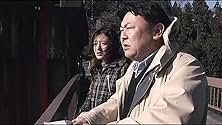अपनी भाषा में प्लॉट जोड़ेंA prominent paranormal journalist Kobayashi goes missing shortly after completing a documentary. What begins as an investigation into strange noises soon evolves into the chilling mystery of... सभी पढ़ेंA prominent paranormal journalist Kobayashi goes missing shortly after completing a documentary. What begins as an investigation into strange noises soon evolves into the chilling mystery of a demonic entity named Kagutaba.A prominent paranormal journalist Kobayashi goes missing shortly after completing a documentary. What begins as an investigation into strange noises soon evolves into the chilling mystery of a demonic entity named Kagutaba.
Duncan
- Guest on TV Program
- (as Dankan)
फ़ीचर्ड समीक्षाएं
Released at the tail end of the J-Horror boom, Noroi is not quite a masterpiece like Ringu (1998), Kairo (2001), and Ju-On (2002). Nonetheless, it is a rare example, and almost certainly the best example, of a found footage movie from the heyday of Japanese horror in the late 90's through mid 00's.
Noroi is a remarkably intricate mockumentary about a journalist's investigation of a series of strange occurrences linked to a folk demon called Kagutaba. In fact, it may be a little too intricate for its own good, and the stream of eccentric characters and disparate video clips threatens to overwhelm us viewers. But critically, Noroi manages to carefully build the creepiness factor and unleash some truly hair-raising scares when the time is right. These scares are mostly of the "supernatural events that are only visible when reviewing video camera footage" variety, and although that is one of the more ridiculous clichés in modern horror, it is extremely effective in the right hands, as it is in Lake Mungo (2008) and here in Noroi.
My only real criticism is that about 50% of the plot is explained in a few perfunctory sentences of narration right at the end, inserted as if the filmmakers had finished the movie and then realized that almost nothing was satisfactorily resolved or explained. I don't necessarily mind baffling movies (Kairo for example is almost completely incomprehensible if you haven't seen the inferior American remake), but as Noroi is based entirely on the investigation of a mystery, I feel like it kind of dropped the ball a little bit right at the end, even with the shoehorned narration.
Found footage seems to be a particularly personal thing when it comes to being terrified; millions (including me) consider The Blair Witch Project (1999) the most frightening movie of all time, while millions of other people think Blair Witch is some kind of joke, and Paranormal Activity (2007) is where the real scares are. Whether Noroi will scare the crap out of you or not is hard to predict, but there is little doubt that this is good stuff. Worth any horror fan's time.
Noroi is a remarkably intricate mockumentary about a journalist's investigation of a series of strange occurrences linked to a folk demon called Kagutaba. In fact, it may be a little too intricate for its own good, and the stream of eccentric characters and disparate video clips threatens to overwhelm us viewers. But critically, Noroi manages to carefully build the creepiness factor and unleash some truly hair-raising scares when the time is right. These scares are mostly of the "supernatural events that are only visible when reviewing video camera footage" variety, and although that is one of the more ridiculous clichés in modern horror, it is extremely effective in the right hands, as it is in Lake Mungo (2008) and here in Noroi.
My only real criticism is that about 50% of the plot is explained in a few perfunctory sentences of narration right at the end, inserted as if the filmmakers had finished the movie and then realized that almost nothing was satisfactorily resolved or explained. I don't necessarily mind baffling movies (Kairo for example is almost completely incomprehensible if you haven't seen the inferior American remake), but as Noroi is based entirely on the investigation of a mystery, I feel like it kind of dropped the ball a little bit right at the end, even with the shoehorned narration.
Found footage seems to be a particularly personal thing when it comes to being terrified; millions (including me) consider The Blair Witch Project (1999) the most frightening movie of all time, while millions of other people think Blair Witch is some kind of joke, and Paranormal Activity (2007) is where the real scares are. Whether Noroi will scare the crap out of you or not is hard to predict, but there is little doubt that this is good stuff. Worth any horror fan's time.
NOROI follows a documentary filmmaker, Masafumi Kobayashi, as he slowly uncovers something mysterious and evil that's leaving a trail of dead bodies in its wake. After interviewing a woman who claims to hear loud baby's cries coming from the house next door (where there is no baby), Kobayashi heads over to talk to the neighbor. He's greeted with hostility by the unhinged, disheveled woman (Maria Takagi) who answers the door (and promptly slams it in his face) and gets a peek at her 6-year-old son through a window. Strangely, both the woman and her son disappear just days after his visit (leaving behind a pile of dead pigeons on their back porch), and the woman who first complained about the noises, as well as her daughter, are both killed in a mysterious accident not long after that. This piques Kobayashi's interest and he sets out on a quest to find out what's going on. He soon uncovers that those with psychic abilities and extra-sensory perception seem to be tuning into something sinister, unexplainable and possibly even apocalyptic. Well-known 10-year-old clairvoyant, and TV celebrity, Kana (Rio Kanno) seems to think we may all be doomed, but she mysteriously disappears before she can be of much help. Another female psychic/actress (Marika Matsumoto) becomes involved, as does Mr. Nori, a mentally unstable kook/psychic who wears a hat and jacket made of aluminum foil and thinks people are being eaten by what he refers to "ectoplasmic worms." Clues eventually lead back to the site of a small village that's now covered by a lake, and the legend of an ancient demon known as Kagutaba...
Unlike many other hand-held horror flicks, this one depends just as much on the plot as it does reactionary first-person scares. Thankfully there's something of a storyline here, a very interesting and intricate one at that, so it doesn't rely on glimpses of horrific things through spastic camera-work every once in awhile to keep your interest. The way Masafumi travels around following leads in search of the truth - with well placed jolts along the way - reminded me somewhat of THE OMEN in its pacing. The film also doesn't entirely consist of footage shot by the documentarian, but weaves in news reports and television variety shows as if what we're watching is an already completed documentary. That helps to break up some of the monotony usually associated with films shot in this particular style. The performances are good enough not to harm any of the realism of the 'actual' footage either. Overall, it's a well-made horror film, with lots of plot shifts, some suspense and quite a few genuinely creepy moments, that's well worth checking out. My only real gripe is that it could have used a little trimming here and there and seems to go on a bit too long. Otherwise, pretty good stuff.
Unlike many other hand-held horror flicks, this one depends just as much on the plot as it does reactionary first-person scares. Thankfully there's something of a storyline here, a very interesting and intricate one at that, so it doesn't rely on glimpses of horrific things through spastic camera-work every once in awhile to keep your interest. The way Masafumi travels around following leads in search of the truth - with well placed jolts along the way - reminded me somewhat of THE OMEN in its pacing. The film also doesn't entirely consist of footage shot by the documentarian, but weaves in news reports and television variety shows as if what we're watching is an already completed documentary. That helps to break up some of the monotony usually associated with films shot in this particular style. The performances are good enough not to harm any of the realism of the 'actual' footage either. Overall, it's a well-made horror film, with lots of plot shifts, some suspense and quite a few genuinely creepy moments, that's well worth checking out. My only real gripe is that it could have used a little trimming here and there and seems to go on a bit too long. Otherwise, pretty good stuff.
I can't praise this film enough. It had a lot of that hand-held, first-person shaking camera which I love (and some hate, because it makes them sick), like REC, Cloverfield and Blair Witch Project.
It is a long movie for its kind, but I didn't even notice because the film was so interesting. By just showing the footage from a paranormal reporter's work the movie keeps up the pace, making it a real-time experience for the viewer.
While I would never call this film the "scariest horror ever made", I'd have to say it's certainly one of the best I've seen. The fear factor here is constructed by details in the images, camera glitches, events linked to one another which lend a very mysterious and haunting tone to the movie. The horror is more in what is not shown, but left to our imaginations. The ending is perfect, and be warned that you might have nightmares afterwards. A second viewing is highly recommended, though.
Watch this one alone in the dark, don't expect anything and you'll have fun.
It is a long movie for its kind, but I didn't even notice because the film was so interesting. By just showing the footage from a paranormal reporter's work the movie keeps up the pace, making it a real-time experience for the viewer.
While I would never call this film the "scariest horror ever made", I'd have to say it's certainly one of the best I've seen. The fear factor here is constructed by details in the images, camera glitches, events linked to one another which lend a very mysterious and haunting tone to the movie. The horror is more in what is not shown, but left to our imaginations. The ending is perfect, and be warned that you might have nightmares afterwards. A second viewing is highly recommended, though.
Watch this one alone in the dark, don't expect anything and you'll have fun.
Kobayashi is a documentary filmmaker who is fascinated by the paranormal. Always looking for new cases to document, he and his cameraman begin investigating a series of freakish events that are seemingly unrelated. To say that he finds more than he bargained for would be an understatement.
Rather than Blair Witch, this one reminded me of The Last Broadcast due to all the different footage involved. There's a sinister atmosphere from the start, but the film manages to be quite funny at times through it's use of stupid variety show footage. If you're familiar with these shows, you know how ripe for lampooning they really are. The storyline itself is quite complex, particularly for the hand-held sub-genre. There are multiple strands and a deep mythology to interpret. It also isn't your typical Asian horror with long-haired ghosts, thank goodness. Instead, we get some legitimate scares through mood and build-up. When we see the flier that says a key character has gone missing, it's enough to give you a chill all on it's own thanks to what we've seen beforehand. There are also a few choice scenes that will stay with you. The two scenes that got the biggest reaction out of me both revolved around Marika, a likable actress who gets caught up in the occurrences through an on location TV shoot. The first involves going back to the tapes and catching something in the frame with her, the second has her losing control in Kobayashi's house as pigeons smash into the window.
The mystery at the film's core is intriguing to watch unfold. At 115 minutes, the film is never boring and it doesn't feel too long. Big compliment, as hand-held horror typically works better when it's short and to the point.
Rather than Blair Witch, this one reminded me of The Last Broadcast due to all the different footage involved. There's a sinister atmosphere from the start, but the film manages to be quite funny at times through it's use of stupid variety show footage. If you're familiar with these shows, you know how ripe for lampooning they really are. The storyline itself is quite complex, particularly for the hand-held sub-genre. There are multiple strands and a deep mythology to interpret. It also isn't your typical Asian horror with long-haired ghosts, thank goodness. Instead, we get some legitimate scares through mood and build-up. When we see the flier that says a key character has gone missing, it's enough to give you a chill all on it's own thanks to what we've seen beforehand. There are also a few choice scenes that will stay with you. The two scenes that got the biggest reaction out of me both revolved around Marika, a likable actress who gets caught up in the occurrences through an on location TV shoot. The first involves going back to the tapes and catching something in the frame with her, the second has her losing control in Kobayashi's house as pigeons smash into the window.
The mystery at the film's core is intriguing to watch unfold. At 115 minutes, the film is never boring and it doesn't feel too long. Big compliment, as hand-held horror typically works better when it's short and to the point.
For better or worse, found footage is the punk rock of film genres. Purposely rejecting the lavish possibilities of polished professionalism in favour of a gritty, distorted mess that celebrates it's own flaws. Noroi: The Curse dives head first into the style, delivering all sorts of shaky, grainy scenes. It's not enough for them to include sequences from imaginary public access shows, but they go out of their way to degrade the video quality until it looks like a 5th generation VHS copy of a copy, and several chilling moments stem from purposeful digital glitches. The technical errors are the art form itself.
In many ways, this works well, as the film manages to skirt past many horror tropes while still finding effective ways to make your skin crawl. It keeps a lot of tragic implications off screen, keeping to a "tell don't show" ethos and never resorting to cheap jump scares. It's impact rides on well established realism and a lot of subtly creepy imagery.
Where the whole format becomes difficult to swallow is in how many traditional film elements have been left behind. Things that can elevate a cinematic experience like cinematography or music cues are largely discarded to serve the mockumentary form. I understand why this was necessary, but I can ultimately only take so many of these things before I start to miss having a nice score pulling on my heartstrings.
In many ways, this works well, as the film manages to skirt past many horror tropes while still finding effective ways to make your skin crawl. It keeps a lot of tragic implications off screen, keeping to a "tell don't show" ethos and never resorting to cheap jump scares. It's impact rides on well established realism and a lot of subtly creepy imagery.
Where the whole format becomes difficult to swallow is in how many traditional film elements have been left behind. Things that can elevate a cinematic experience like cinematography or music cues are largely discarded to serve the mockumentary form. I understand why this was necessary, but I can ultimately only take so many of these things before I start to miss having a nice score pulling on my heartstrings.
क्या आपको पता है
- भाव
Masafumi Kobayashi: No matter how terrifying, I want the truth.
- क्रेज़ी क्रेडिटThere are no closing credits except for the names of the studios involved in Noroi's production.
- कनेक्शनFeatured in WatchMojo: Top 10 Fantastic Asian Movies You Have Not Seen (2018)
टॉप पसंद
रेटिंग देने के लिए साइन-इन करें और वैयक्तिकृत सुझावों के लिए वॉचलिस्ट करें
- How long is Noroi?Alexa द्वारा संचालित
विवरण
बॉक्स ऑफ़िस
- बजट
- $20,00,000(अनुमानित)
- दुनिया भर में सकल
- $7,167
इस पेज में योगदान दें
किसी बदलाव का सुझाव दें या अनुपलब्ध कॉन्टेंट जोड़ें




















